Every bookstore has the daily challenge of tidying up after customers, especially little customers. One of the joys of owning a bookstore is seeing people of all ages browsing the shelves and finding books they want to look at. People try to be helpful by putting their looked-at books away; mostly they do a great job of this, but sometimes, it’s more of a crap shoot and it’s our job as booksellers to put them back where they belong.
The joy of a bookstore is everything is alphabetically arranged by author. It isn’t really rocket science, although I will freely admit that the non-fiction section with its various shelves of subjects can stymie this seasoned bookseller at times. I’ve learned some things that are helpful when trying to re-alphabetize the store.
In the adult section, most misplaced books are going to be eye level or higher. Adults tend to put things back in a way that’s the easier for them and this makes sense. Easier often winds up at eye level, with books placed on top of the books on the shelf. This sort of person actually makes it easier for me to see what’s awry. They are acknowledging that they think the book goes back where they’ve placed it, but aren’t totally confident of its resting place on the shelf, so they leave it near where it should be. This is actually helpful. It’s very easy to scan to the shelves for books on their sides and return them to their rightful home. The lower shelves of the adult section are almost never out of order, it’s the top two that are the challenge.
The children’s section is the exact opposite. Yes, books wind up on their sides all the time, but more than likely what happens in picture books is testament to the size of the browsers. Little ones like to help put things away at the store just as they do at home. They don’t yet understand alphabetical order; they’re not reading yet. They just know if they put the book back on the shelf they’ve done the right thing, because that’s how clean-up works at home. So, I’ve learned that if you’ve only got a few minutes to alphabetize the picture books, always start with the bottom shelf.
All manner of bad things happen on the bottom shelf of picture and board books. Books are put back upside down, torn books often wind up stuffed in among the others, books are out of order because they are often from the stack the family was reading and the little one helped before the parent could say, “Sweetie, just leave the pile.” Every bookseller I know would much rather have a stack to shelve than a try to figure out where the books might have been mis-shelved.
I like it when kids help put away books with guidance. But there is a constant challenge of things not being put back right so I can’t find something later when a customer is looking for that particular book. It’s all a balancing act. I do love little toddlers returning each rubber bath toy to its rightful home. Proudly, they take a toy (it’s always one at a time) and gently place it in the basket and then repeat for as long as it takes. I will usually show slightly older kids the easiest way to return books to the shelf: use both hands, check that the jacket is all the way down and then gently place the book on the shelf. I don’t worry about alphabetically much with the little ones but older kids are pretty good about doing it right.
So, the next time you’re in a busy bookstore and their computer says they have one copy of a picture book and cannot find it, be patient, it’s probably on the bottom shelf.
Monthly Archives: April 2014
Don’t Make Me Do All the Work
Josie Leavitt - April 28, 2014
The struggle of any small business is to get other small businesses to buy their products. Bookstore owners are besieged daily with people who think their sidelines would be just perfect for the store. I have to admit, I have become somewhat cranky about these solicitations. So, here is a list that I hope folks will find helpful in approaching bookstores to carry their products.
– Do not cold call the bookstore. I like that just a bit more than folks coming in and expecting me to stop what I’m doing and listen to their pitch. One vendor recently called and tried to pitch me posters that he thought would be a good fit here. I asked if he could email and he said, “Nope, don’t do it.” Then I inquired about the web site and was met with, “Nope, don’t have one.” So, let me understand: you expect me to buy art sight unseen based only your description of what the product looks like? Really??
– If you send an email please include all the product information. Do not send an email that mentions a website without including a link to the it. I know this is a silly point, but being able to click on a link is easy and get right to the website is far more likely to get me look at what you’re trying to sell.
– Follow up less frequently than you think you need to. If it’s been two weeks and no one has gotten in touch with you, then it’s okay to call. Then let it be. I know this is frustrating, but here’s the thing: if something catches a buyer’s eye they will deal with it fairly immediately. Calling every day (yes, this happens) is a sure-fire way to make me not want to buy your products.
– Respect my time. If I do talk with you on the phone, please listen if I’m trying to gently tell you that your silicon spatula line for children is just isn’t a good fit for us.
– Do your homework. Go to my website and see what kind of store we are. While I am not likely to need spatulas, cool 3-D bookmarks might be an excellent fit.
– Lastly, do not mail a sample unless I’ve expressed interest in your product. I don’t want you to spend the money on giving me a free sample and shipping unless it’s something I really want.
Series Books: An Exercise in Waiting
Elizabeth Bluemle - April 25, 2014
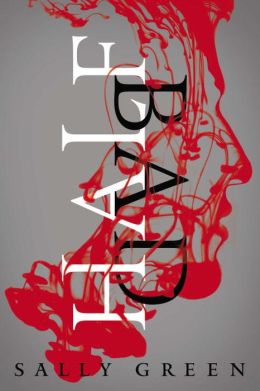
I’m as much a product of modern convenience as the next person—maybe even more so, since I grew up with a Dad who leapt to test out the next new gadget or gizmo: Pong, laser discs, holographic sculptures, Space Food Sticks. (I know!) So waiting is not always my strong suit. When I discover something terrific — the His Fair Assassin series by Robin LaFevers, say, or Netflix’s Orange Is the New Black, or, this week’s yearning for book 2 of Sally Green’s Half Bad series — I want the next installment right away. Internally, I’m stamping my impatient feet.
Soon, we’ll be able to 3D print a new pair of shoes for those feet right at home. But we still won’t be able to rush an author, and that’s a good thing. Even though it’s hard to wait, there’s something important about delayed gratification. We value what we wait for. We get to experience the deliciousness of anticipation. And waiting is a humbling reminder that we are not the architects of our own little worlds, as much as we may try to be. Back in the glory days of buildup to a new Harry Potter book, kids would complain about the wait for each volume. Their desire for the new story was so intensely felt, they would vibrate with it. I’d say, “Think of it this way: You are the only generation that gets to experience this excitement. The midnight parties and predictions about what will happen to the characters… this worldwide anticipation… will never happen again in the history of the universe, and you get to be here for it!” I don’t know how much it helped assuage the agonized longing, but it was true, and I think at least some of the older kids appreciated it. (Of course, I was also playing to the desire for specialness, their own echoes of Harry-Potter destiny, and don’t think I didn’t know it. But, it was still true.) It will be the equivalent of the old codger whining at kids about having to walk two miles to school in a blizzard with no shoes. “Back in my day, we had to wait three years before we could read The Order of the Phoenix. THREE YEARS!”
So I was extremely pleased to suffer at the end of the aforementioned Half Bad by Sally Green. I had picked up the ARC a while ago, and put it down for a bit because it starts off dark, and I wasn’t sure I was up for reading about a maltreated boy who is kept in an outdoor cage. I am often drawn to dark books, but cruelty has never been easy for me to stomach, so I kept my distance. But the bookseller buzz was so strong — there really is nothing as effective as word of mouth! — I gave it another chance, and this time, I was hooked. Without going into too much spoiler material, the main character is a young male witch coded as a dangerous Half White Half Black Witch. (The full implications of the racial overtones built into those terms, “white” and “black,” remain to be seen; we suspect that the maligned Black Witches may be persecuted than persecuting, but by the end of book 1, while we know that many of the White Witches are truly evil, we still don’t know for sure what the story is with the Black Witches.)
This blog post is not intended to be a book review but a discussion of frustration, so I will end here and merely ask, How do you approach a new series? Do you wait until all the books (or TV episodes) are out before even beginning? Or do you, like me, enjoy the anticipation? And what, pray tell, are you waiting for right now?
Smartphones in the Bookstore
Josie Leavitt - April 24, 2014
The advent of new technology has been a boon for the bookstore as well as a liability. Smartphones make it easy to communicate with staffers when I’ve forgotten something that needs doing. They allow me to jot down notes when I’m away from the store and more importantly, they help customers remember book titles. The dark side of the phone is they can take photos of books that customers will order elsewhere.
Being able to communicate with staffers in a way that doesn’t involve the phone works really well for me. Sometimes, I have a quick, non-urgent item I just need to share that doesn’t merit a phone call; I know if I wait till I’m back at the store it will be lost from my memory. Staffers will text me similar things. Often, when I’m not at work, I’m not really able to speak on the phone, so texting allows us to stay in touch. Yesterday, for example I was taking a four-mile walk at Shelburne Farms where the cell phone reception is bumpy at best, but texts come through just fine. In three texts, Sandy and I solved the problem of the eight book Police Exam special order efficiently with smiley faces, no less.
Customers use their phones as a way to remember what books they want to order. Often, there are copious pages of notes with book titles or jottings of when and where they heard about a book. Being able to dictate often results in notes like this: Fresh Air, Monday, Prison book. That is more than enough to go to find a book, and since the notes are automatically dated, it’s so much simpler to find the titles. Sometimes, people bring us photos of books they’ve seen elsewhere. That’s enormously helpful, although I always feel bad if they’ve taken a picture at another indie. I never feel bad if it’s from a chain store or Costco. Any device that helps customer retain book information is a win-win for everyone.
The down side of a smartphone at the bookstore is when people take pictures of books they want to order on Amazon. Or, more stingily, books they’re ordering on Amazon while in my store. Some people are brazen about it, clearly having no compunction about using our store as their Amazon showroom. Others are at least a little bit sheepish about it and try to be more discreet. It’s hard to not react when it’s clear someone is photographing book covers in the store or scanning QR codes. I don’t say anything, but I do try to notice what books seem to be getting the most cell phone activity. I do wonder, sometimes about generating my own QR code labels and putting them on books so customers would be led right back to my website.
Lastly, the beauty of cell phones at the store is getting photos from staffers about cute things at the 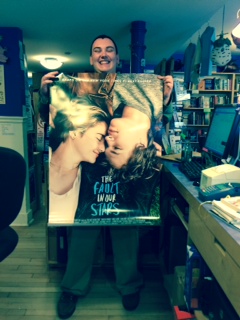 store. Usually, it’s a puppy or a really cute baby holding a book. But Tuesday, our youngest staffers were working together and Laura texted that there was $2.91 postage due on a poster tube. She wanted me to know that she paid the postage from petty cash. I said it was all right and then I got this photo texted to me. Not only did that poster cost us $3, it’s enormous. And it’s a promo for the movie. But it was funny and all because everything about it could be shared, and that’s a good way to use a phone.
store. Usually, it’s a puppy or a really cute baby holding a book. But Tuesday, our youngest staffers were working together and Laura texted that there was $2.91 postage due on a poster tube. She wanted me to know that she paid the postage from petty cash. I said it was all right and then I got this photo texted to me. Not only did that poster cost us $3, it’s enormous. And it’s a promo for the movie. But it was funny and all because everything about it could be shared, and that’s a good way to use a phone.
Tip Sheet: Picture Books Are for All Ages
Elizabeth Bluemle - April 22, 2014
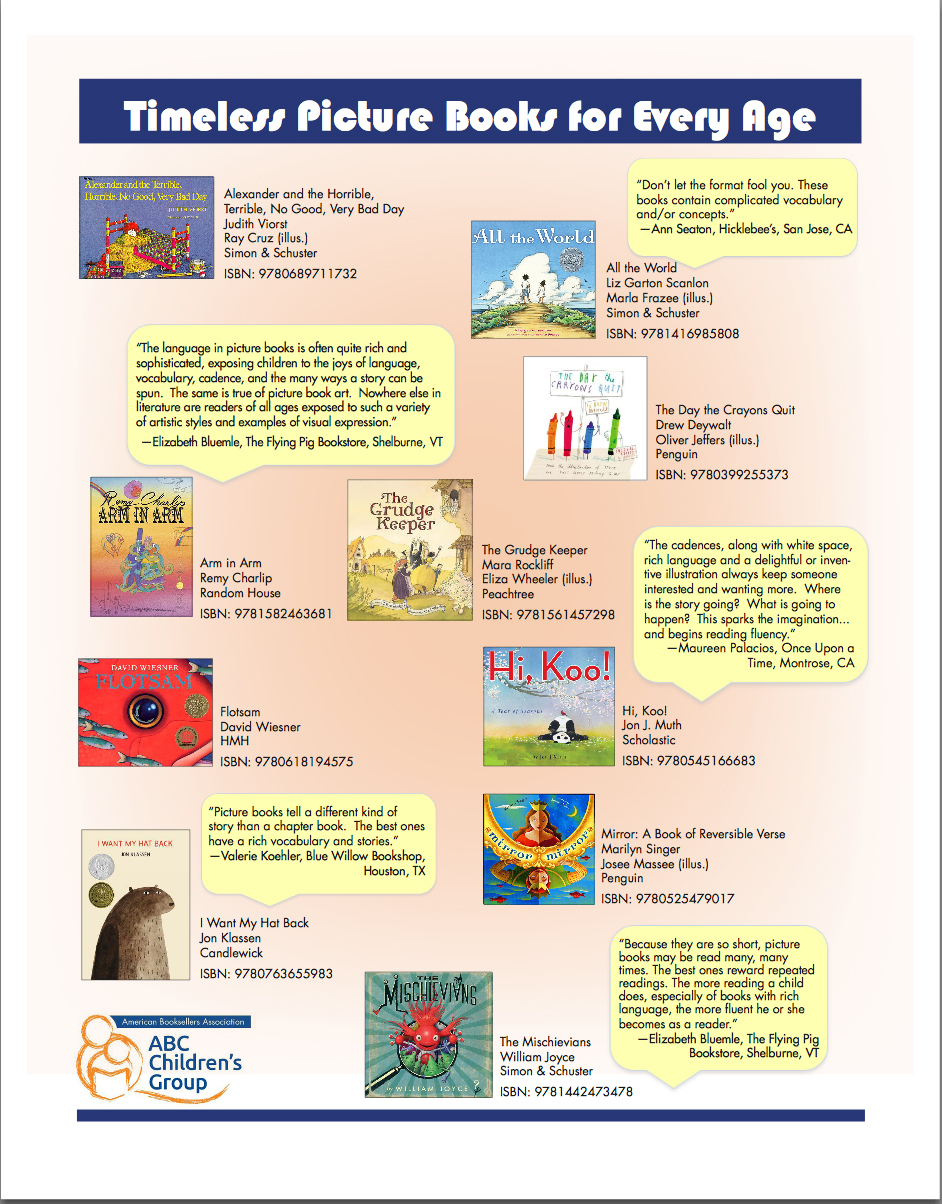 Recently, I wrote a blog post (Are We Rushing Kids Out of Picture Books?) about the way children are pushed toward chapter books at younger and younger ages. The topic struck a nerve; thoughtful comments poured in. Then at the ABC Children’s Institute in San Antonio earlier this month, I was on a panel discussing this topic (Selling Picture Books in the Wake of Age Compression) with several other children’s booksellers and librarians, and the room was overflowing and the conversation energetic. Clearly, this is a subject people feel passionate about!
Recently, I wrote a blog post (Are We Rushing Kids Out of Picture Books?) about the way children are pushed toward chapter books at younger and younger ages. The topic struck a nerve; thoughtful comments poured in. Then at the ABC Children’s Institute in San Antonio earlier this month, I was on a panel discussing this topic (Selling Picture Books in the Wake of Age Compression) with several other children’s booksellers and librarians, and the room was overflowing and the conversation energetic. Clearly, this is a subject people feel passionate about!
The panelists were (including me): Elizabeth Bluemle, Flying Pig Bookstore (Shelburne, VT); Maureen Palacios, Once Upon a Time (Montrose, CA); Ann Seaton, Hicklebee’s (San Jose, CA); Marianne Follis, Ph.D, senior librarian at Valley Ranch Library (Irving, TX); moderated by Valerie Koehler, Blue
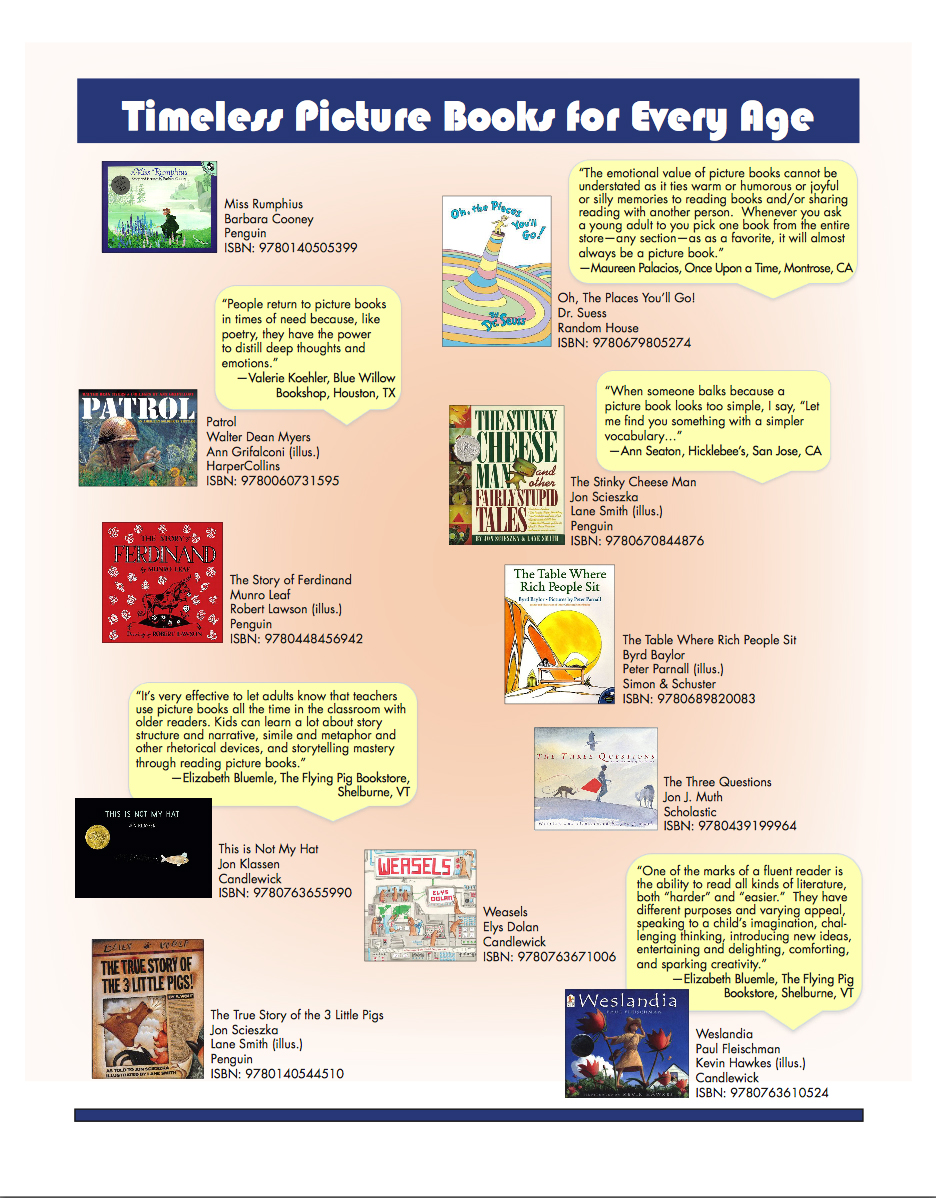
Willow Bookshop (Houston, TX).
I thought I would share the terrific list of suggestions made by the panelists and the attendees. Because the discussion was rapid and I was writing by hand, I couldn’t attribute each suggestion to its bookseller, so thank you to all of the fabulous folks who shared their expertise and great ideas!
Also, the ABC made a wonderful poster that bookstores (and schools and libraries) might want to use, as a handout for customers and staff members.
I’ve divided the suggestions into categories: Talking Points, Display Ideas, Staff Training, and Quotables. Please feel free to print out this bulleted list and share it with your bookselling, library, and teaching colleagues if you think it would be helpful.
INDEPENDENT BOOKSELLERS’ TIP SHEET: PICTURE BOOKS ARE FOR ALL AGES
Customer Education and Handselling Tips
The term “picture book” simply refers to a book format in which art and text depend on one another for the full meaning of the book to emerge. Picture books span a wide range of intended ages. There are picture books for babies, picture books for just about every age of childhood, and picture books for adults.
Though they may seem simple, picture books often contain more sophisticated language than chapter books, because they are intended for fluent readers to read aloud, not for beginning readers to sound out. So an adult trying to move a child toward a more challenging read might in fact find that challenge right there in the picture book section.
It’s very effective to let adults know that teachers use picture books with older kids all the time in classroom settings. In addition to sparking various kinds of social studies conversations and explorations of art and the interaction of text and art, picture books can teach kids a lot about story structure, narrative, rhetorical devices, voice, and storytelling mastery.
Wow them with science: A child development expert friend of mine said that picture books connect our visual and auditory cortex with our frontal lobe in a way that even illustrated chapter books don’t. For example, the illustrations in a picture book often introduce an unwritten subplot, tell mini-stories not in the text, or actually contradict the text — inviting the brain to make connections in a way that chapter books generally don’t.
Picture books are excellent for social-emotional development. A picture book can be the fastest way to spark a conversation or get to the meat of a topic with older kids.
Relatability is crucial; often children are rushed away from books that are developmentally appropriate for their abilities and interests, and into books they won’t get nearly as much out of. (One bookseller asks children who pick chapter books that are meant for older kids to promise to re-read the book when they are older, and some kids have come back and said, “It’s a totally different book now!”)
A 32-page picture book may cost the same as a 350-page novel, but a picture book is read over and over again, and each time there may be something new to discover. The more reading a children does, especially of books with rich language, the more fluent he or she becomes as a reader.
Don’t give away your child’s board books too soon; they are perfect for when a child becomes a beginning independent reader, and he or she can read those old favorites to littler siblings, to pets or stuffed animals.
The language in picture books is often quite rich and sophisticated, exposing children to the joys of language, vocabulary, cadence, and to the many ways a story can be spun.
The same is true of picture book art. Nowhere else in literature are readers of all ages exposed to such a variety of artistic styles and examples of visual expression.
Wordless picture books: suggest that older siblings ‘read’ wordless picture books to younger siblings.
Author Aaron Becker (Journey; Quest) has written a wonderful guide to ‘reading’ wordless picture books aloud.
One of the marks of a fluent reader is the ability to read all kinds of literature, both “harder” and “easier.” They have different purposes and varied appeal, speaking to a child’s imagination, challenging thinking, introducing new ideas, entertaining and delighting, comforting, and sparking creativity.
How many kids get turned off reading because they’re pushed too fast away from the books they truly love?
Humor trumps all. Find the funny intelligent book, the funny artistic book, the funny musical book, etc., and your customer will be hooked.
A terrific article in the May/June 2011 issue of the Horn Book finds author/artist Marla Frazee and her editor, Allyn Johnston, discussing “Why We’re Still in Love with Picture Books (Even Though They’re Supposed to be Dead.” Also, the Horn Book has many interviews with artists; sharing these with parents can help them better appreciate the treasure trove of visual literacy picture books provide.
Quotables
“A picture book is not an age. It’s a form.”
“It’s never too late for a great picture book.”
Call the longer, older-aimed picture books “picture novellas.”
For adults wanting to steer their children toward a chapter book that is simply too old for their child developmentally: “Just because they CAN read a book doesn’t mean they SHOULD.” (Books resonate with different ages differently.) OR: “They can read it, but they will get so much more out of it when they’re [perfect age for book].”
Again, for adults steering their children away from age- and interest-appropriate picture books: “Relatability is the single biggest factor for a book’s success with a child.”
For younger children wanting to choose a chapter book because it’s thick and looks like what their older siblings/friends are reading: “That’s [chapter book] a good book to carry around, but this [picture book] is a great book to read!”
“We aren’t gatekeepers, but guides.” Our job is to help children find the books they will love deeply, the right books at the right time. (One great strategy a bookseller used for discouraging a too-young kid from reading The Hunger Games was to ask, “Are you into politics?” At six or seven, the answer was a resounding NO. That approach helps place the decision in the child’s hands, with a little help.)
Staff Training (for General Bookstores as well as Children’s-Only)
New staff training — the store tour always ends in the picture book section.
One store has daily story time; new staff (in all sections, not just children’s) must watch every story time for two weeks.
Staffers are encouraged to take a stack of picture books home every single day. You can’t recommend what you haven’t read.
Storytime for staff — take time for some impromptu readings of picture books during the work day.
Staff read picture books out loud occasionally at the front counter; it always sells books.
As you receive new picture books, take time to share them with colleagues.
Everyone on staff must spend a half hour per week in the children’s department.
At staff meetings, have each bookseller bring a favorite picture book to ‘handsell’ to colleagues.
Write reviews from the proofs of picture books pre-publication; that way, the buyer’s enthusiasm for the picture book is fresh. The shelftalker will help familiarize other staff with the books when it eventually comes in.
Display or Event Ideas That Have Worked Well
Staff Picks Comfort Books: Make a display of staff picture-book comfort reads (i.e., picture books read by adults) with shelftalkers from staff members explaining why they love and turn to this book in times of stress or sorrow.
Tie in with current events or culture: When Cosmos aired on PBS, for example, one bookstore did extremely well with a display on space-related picture books. Another store did an entire window display on picture books featuring numbers in some way; this display sold amazingly well.
Great All-Family Read-Aloud Picks: This display highlights picture books that appeal to ALL ages, not just the family’s youngest members.
Some stores arrange picture books by age range: baby books; preschool to kindergarten; elementary age.
Pair a picture book with a novel for children’s in-store book groups.
*************
Please feel free to share some of the tips that work well in your store (or library)!
A Cautionary Morning
Josie Leavitt - April 21, 2014
I have written before of my relationship with my local coffee shop, Villiage Wine and Coffee. I am there every day that I work, and most days that I’m not at the store. They start making my drink before I reach the counter; they draw a picture on my cup daily, they provide breakfast now and stock the oatmeal that has all the berries because it’s all I eat, etc. They are closed for the week to refinish their floors and I am bereft.
They are only closed until Friday, when they’ll reopen with a shiny new floor. But the lack of them in my week has gotten me thinking about how I’ve come to need them. Yes, I love coffee, but it’s so much more than that. Kevin’s, as we all call it, is where I go to see friends and get hugs. I can get caught up on news in the village by going there and I never know who will be there that I know and enjoy. Kevin and I talk about the plight of small businesses in this world of people getting everything online cheaper but at a steeper personal cost.
Again, I am reminded of the importance of shopping at the places you want to stay open. In our small village with our collection of a dozen or shops, there is a deep reliance on our core customers. We feel the lack of each one when they move, or when they get an e-reader and stop buying books. Yes, I know they can buy e-books from us, but most prefer to go to Amazon or iTunes. I guess this week I’m getting a preview of what would happen if the coffee shop ever closed. And I do not like my world without it.
I had an idea for the village stores to make a point about how much they are needed. I wondered what would happen if we all closed for one day, or even half a day. And rather than being open we would explain to customers the importance of them choosing us over online shopping. I wanted the total dramatic effect of shuttered stores for the day with OUT OF BUSINESS signs in the windows. I wanted people to see just what it would feel like if we all closed. I know people have the best intentions about where they spend their money. But it’s easy to get caught up in the ease of online shopping and forget that every dollar spent online is a dollar that your local store needs. Not only does the local store need it, but more of that dollar stays in your town. I envision a day where everyone gets it and realizes that where you spend every retail actually really does matter.
For now, I will try to remember to make extra coffee at home to bring to work and count the days until Friday.
Fabulous First Lines 2014, Round 2
Elizabeth Bluemle - April 18, 2014
 Last week, I posted some of the best, most fun, striking, and otherwise notable opening lines from this year’s middle grade and young adult novels. This week, intrepid Flying Pig staffers Sandy and David helped me gather the next round. And at the end of the post are lines offered last week by alert ShelfTalker readers. Keep ’em coming, folks!
Last week, I posted some of the best, most fun, striking, and otherwise notable opening lines from this year’s middle grade and young adult novels. This week, intrepid Flying Pig staffers Sandy and David helped me gather the next round. And at the end of the post are lines offered last week by alert ShelfTalker readers. Keep ’em coming, folks!
“Okay. I got one. Would you rather live every day for the rest of your life with stinky breath or lick the sidewalk for five minutes?” Noodles asked. —When I Was the Greatest by Jason Reynolds (S&S / Atheneum)
There is an uneasiness that remains after your best friend tries to kill you. —The School of Good and Evil: A World Without Princes by Soman Chainani (Harper)
I never set out to pose nude. I didn’t, honestly. —A Mad, Wicked Folly by Sharon Biggs Waller (Viking)
There are six teams today in the Eastern Shore Baseball League. Tomorrow there will be none. —The Right Fight (World War II, Book 1) by Chris Lynch (Scholastic)
My art teacher says that a real artist bleeds for her craft, but he never told us that blood can become your medium, can take on a life of its own and shape your art in vile and gruesome ways. —Unhinged by A.G. Howard (Abrams / Amulet)
Grandpa stopped speaking the day he killed my brother, John. —Bird by Crystal Chan (S&S / Atheneum)
The empty cafeteria table snapped in half at the middle and shot up off the ground. —The Quantum League: Spell Robbers by Matthew J. Kirby (Scholastic)
The crackle and hiss of the flames devouring our house couldn’t block out the screaming and wailing of those who were still alive. —Defy by Sara B. Larson (Scholastic)
That’s the trouble with milking french fries—slippery elbows. —Zits: Shredded by Jerry Scott and Jim Borgman (HarperTeen)
Listen—I was alive once and then I wasn’t. Simple as that. Now I’m alive again. The in-between part is still a little fuzzy, but I can tell you that, at some point or another, my head got chopped off and shoved into a freezer in Denver, Colorado. —Noggin by John Corey Whaley (S&S / Atheneum)
The first thing we had to do was catch the Tralfamosaur. —The Eye of Zoltar by Jasper Fforde (Houghton Mifflin Harcourt)
The problem, or thrill, depending on how you choose to look at it, was that our relationship was practically based on an enthusiastic mendacity. —little blue lies by Chris Lynch (Simon & Schuster)
J. Rutherford Pierce smiled as the six mercenaries filed into his London office. —39 Clues Unstoppable Book 2: Breakaway by Jeff Hirsch (Scholastic)
I was raised to marry a monster. —Cruel Beauty by Rosamund Hodge (HarperCollins / Balzer + Bray)
In musicals, characters break into song when their emotions get to be too big. —Five, Six, Seven, Nate! by Tim Federle (Simon & Schuster)

The night heat melted over me, the quiet unsettling since the laughter had stopped. —The Lure by Lynne Ewing (HarperCollins / Balzer + Bray)
Outlaws have too many feathers in their hats. —The Hero’s Guide to Being an Outlaw by Christopher Healy (HarperCollins / Walden Pond)
The natural and the supernatural inhabit the same world, intersecting but largely unseen to one another, like lodgers who share a house but keep different hours, only occasionally passing on the narrow stairs. —When They Fall, So Do We All by Charlie Fletcher (Little, Brown / Orbit)
I’m having my favorite dream again—the one where I’m about to be crowned Greatest Underwater Wrestling Champion of the World, Ever. —Shark School: Deep-Sea Disaster by Davy Ocean (Simon & Schuster)
Lucia was sure that the white-haired gentleman reclining on the dining couch before her would make a delightful grandfather. As a future husband, though, he left a great deal to be desired. —Curses and Smoke by Vicky Alvear Shecter (Scholastic / Arthur A. Levine)
Presumed dead does not mean dead. They didn’t find his body. —Swim That Rock by John Rocco & Jay Primiano (Candlewick)
The man in the fog was watching her. —Ore: The Foundry’s Edge by Cam Baity and Benny Zelkowicz (Disney-Hyperion)
If there was one thing worse than seeing a giant’s head rise from the ground, it was seeing two giant heads. —Odin’s Travels (The Blackwell Pages) by K.L. Armstrong & M.A. Marr (Little, Brown)
Epigraph from Part One: A Girl of Wax: Nothing is more enjoyable than educating a young thing—a girl of eighteen or twenty, as pliable as wax. —Adolf Hitler —Prisoner of Night and Fog by Anne Blankman (HarperCollins/Balzer+Bray)
Deep in the black mountains, deep in the Romanian night, deep beneath the cold, dark waters of the ancient Olt, the river witches sang. —Deep Blue by Jennifer Donnelly (Disney Book Group)
ShelfTalker reader Deb Marshall contributed this marvelous entry:
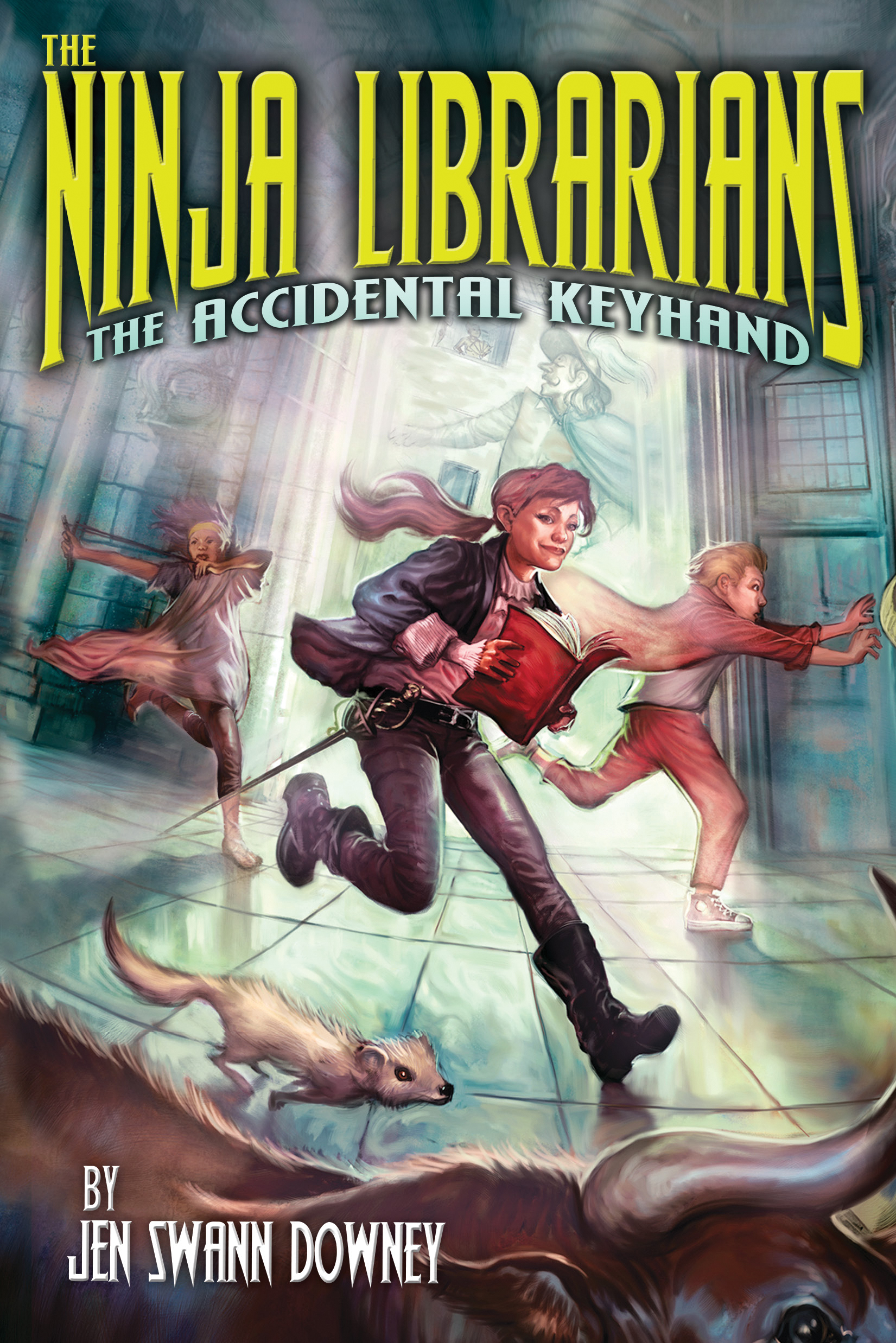 Twelve–year–old Dorothea Barnes was thoroughly un–chosen, not particularly deserving, bore no marks of destiny, lacked any sort of criminal genius, and could claim no supernatural relations. Furthermore, she’d never been orphaned, kidnapped, left for dead in the wilderness, or bitten by anything more bloodthirsty than her little sister. —Ninja Librarians: The Accidental Keyhand by Jenn Swann Downey (Sourcebooks Jabberwocky)
Twelve–year–old Dorothea Barnes was thoroughly un–chosen, not particularly deserving, bore no marks of destiny, lacked any sort of criminal genius, and could claim no supernatural relations. Furthermore, she’d never been orphaned, kidnapped, left for dead in the wilderness, or bitten by anything more bloodthirsty than her little sister. —Ninja Librarians: The Accidental Keyhand by Jenn Swann Downey (Sourcebooks Jabberwocky)
This dryly funny line comes from ShelfTalker reader Michelle Weeks. Amen, sister!:
It wasn’t that Jinx didn’t like people. It was just that sometimes he had to get away from them. —Jinx’s Magic by Sage Blackwood (HarperCollins / Katherine Tegen)
And these goodies are from ShelfTalker reader Summer Laurie (who also noted the line from The School for Good and Evil above):
Despite my mother’s best efforts, I never forgot the day my grandmother taught me how to tie the winds. –Salt & Storm by Kendall Kulper (Little, Brown)
For the body, you go to the mortuary. — Six Feet Over It by Jennifer Longo (Random House)
On the day Liz Emerson tried to die, they had reviewed Newton’s Laws of Motion in Physics class. Then, after school, she put them into practice by running her Mercedes off the road. — Falling Into Place by Amy Zhang (Greenwillow)
Are We Still Talking About This?
Josie Leavitt - April 17, 2014
Earlier this month, there was an blog post on the New York Times site about the negative effect that e-books can have on young readers’ (not fluent middle grade or older readers, but emerging readers) ability to understand what they’re reading. Really? This is news? Am I the only who is not shocked to hear this?
Take a four-year-old and give him an e-book and watch what happens. He “reads” it like a game, with buttons to press, new noises to make, etc. While he might be enjoying himself, he’s not reading, he’s playing — and these are two distinctly different and very important activities. Learning how to read requires a bit of hard work and concentration. “It seems that the very ‘richness’ of the multimedia environment that e-books provide — heralded as their advantage over printed books — may overwhelm children’s limited working memory, leading them to lose the thread of the narrative or to process the meaning of the story less deeply,” says Anne Murphy Paul from the MotherLode blog in the Times. Kids are having time focusing on all the bells and whistles but are missing the story. Of course they are. They’re kids.
Take that same boy, and this is not a scientifically proven thing, just 18 years of selling books to children, and give him the same book as a physical book and he will be engaged. He will try to predict, he will point out things he knows, and those things won’t wiggle or squeak when he touches them. He will make up his own noises for them. Maybe he’ll just run his little finger over the drawing to see if it feels like something. Maybe he’ll let his imagination wander and wonder. He will get ready to turn the page when he feels like it. The paper will have a texture and a smell. And if he grows up to be a reader, he will surreptitiously sniff every book he buys for the rest of his life.
Reading as a tactile event. How the pages turn is important, especially with picture books. Learning the right way to turn the page is a huge skill for young readers. I used to love turning the pages when my mom would read to me. Almost all books feel different from one another. As a reader, you develop a relationship with the book. How does it feel when you’re reading it? Are the pages shiny, sometimes too shiny, and you have to angle it a different way from the light. This is important for little minds to grasp. There is so much subtlety with reading a book that is lost with an e-reader.
So, give the kids back their books and let them learn to love to reading.
Getting Books to Kids for Free
Josie Leavitt - April 15, 2014
Kids and books should always go together, but sometimes there are financial issues that prevent this. Last week I got to see a great program that worked to remedy this. Literacy Night at the Lothrop School strived to get every student a book.
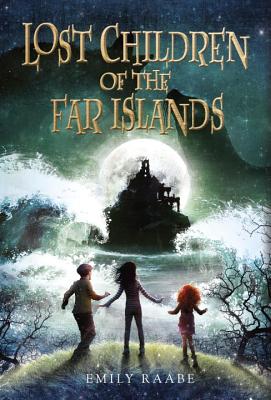 Last week, Emily Raabe, debut novelist of the recently published Lost Children of the Far Islands, and I traveled down to Pittsford, Vermont to the Lothrop School for their annual literacy night. Emily was our first-ever employee 17 years ago. It’s a real thrill to be able to sell her book! There is a lovely symmetry to that which delights me. Emily’s sister, Sara (also a former Flying Pig staffer), just happens to be the principal of the school. Their literacy night includes kids in jammies (see this post for how literacy night worked in Maine with Elizabeth Bluemle) and children having different classrooms to hear different stories, then coming back together as a group for an author reading.
Last week, Emily Raabe, debut novelist of the recently published Lost Children of the Far Islands, and I traveled down to Pittsford, Vermont to the Lothrop School for their annual literacy night. Emily was our first-ever employee 17 years ago. It’s a real thrill to be able to sell her book! There is a lovely symmetry to that which delights me. Emily’s sister, Sara (also a former Flying Pig staffer), just happens to be the principal of the school. Their literacy night includes kids in jammies (see this post for how literacy night worked in Maine with Elizabeth Bluemle) and children having different classrooms to hear different stories, then coming back together as a group for an author reading.
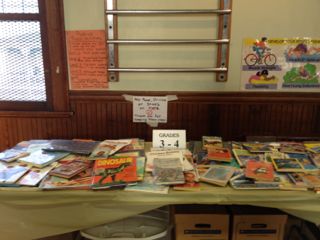
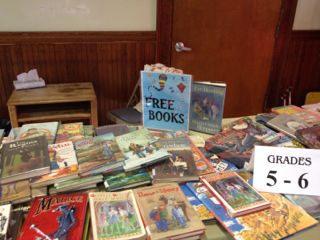 Of course the kids were adorable, and yes, there was much discussion about books and stories. But what made this event stand out were the free books for the kids. I walked in the gym and there were four tables of books arranged by ages from first grade right through fifth. As kids streamed into the gym they circled the tables and eyed the books they knew they couldn’t touch until after the presentation. The kids at this school are among Vermont’s rural poor with almost half of them qualifying for free lunches. Pittsford is a town that reflects the changing face of Vermont with a mix of farming kids and kids whose families have been caught up in heroin and meth addictions.
Of course the kids were adorable, and yes, there was much discussion about books and stories. But what made this event stand out were the free books for the kids. I walked in the gym and there were four tables of books arranged by ages from first grade right through fifth. As kids streamed into the gym they circled the tables and eyed the books they knew they couldn’t touch until after the presentation. The kids at this school are among Vermont’s rural poor with almost half of them qualifying for free lunches. Pittsford is a town that reflects the changing face of Vermont with a mix of farming kids and kids whose families have been caught up in heroin and meth addictions.
This was Emily’s first event for her book and she did really well. The kids seemed to have a hard time settling down and were a little chatty throughout her reading. While they may have been talking, they were paying good attention and asked many questions about the book and being a writer. One child asked, after hearing how many drafts Emily wrote, “Why don’t you have gray hair?” Emily deftly handled this one. She was also extremely kind when kids misheard her asking if they knew what a selkie myth was and hands shot up and a boy said, “I know what a selfie is: it’s when you take your picture with a phone.”
Kids bought Emily’s book and while they were waiting to get them personalized, the book tables were opened. Sara explained, “We’re going for controlled chaos.” Children streamed to the appropriate tables and carefully choose one book each that had been scoped out before. Every student left with a book. And I was left with a very happy feeling to be part of such of a special evening.
Successful School Visits
Josie Leavitt - April 14, 2014
School visits, if done well, can be win-win situations for the school, the author and the sponsoring bookstore. Bringing authors into a school is a gift for students, and often one that stays with young people for the rest of their lives. Often, if school visits are part of an author’s tour and that author is already going to the bookstore, the visit will be free. This is a huge boon to schools. The best school visit usually require at least one school staffer, often the librarian, to help organize and cheerlead the event. Below is a list of tips to make them as successful as possible.
– If a school, even the one that is most local to the bookstore, doesn’t actually order books from the bookstore, they are not likely to get offered visiting authors. This is definitely a case of helping the school that supports the store.
– Someone at the school must actually be excited about the visiting author. If there is tentativeness on the school’s part there is the potential for a bad visit. It’s totally okay to say no. The flip side of this works for stores, too.
– In a perfect world there would plenty of time to plan and perhaps do an author study and get the kids excited about meeting the author. We all know this is not a perfect world. But even with limited notice there are ways to get kids excited for author visits by reading the first few chapters of a book to the class in advance of the visit. It doesn’t take much to get kids intrigued by authors.
– Order forms must be easy and given to the school in a timely way. We offer our standard school discount to all books purchased for an author event. All order forms must be turned back to the bookstore at least a week prior to the event. I’m always surprised at what books the kids want and it’s often not the one the author is touring in support of; it’s usually the one you never expect and the one that’s hard to get. Allowing enough time to get the books in is vital.
– Bookstores must be really organized about the book orders and how the kids want them signed. I usually let Elizabeth do this for us. She’s meticulous and her system really works. Each child’s book(s) is rung up, the receipt stapled to the form and then the book is wrapped in the form. Then the books are organized by classroom and brought to the school for the author to sign.
– Authors need to make sure their computer/flashdrive/Power Point, etc works. Nothing is more frustrating than needing a Mac and only having PC things. I know it’s more to lug around, but if you bring your laptop from home, then you’ll know everything will likely work.
– Don’t schedule every minute of the day for the author. I know it’s a case of wanting to get the most out of the visit and getting as many kids to see the author as possible, but this is hard work and authors need time to eat, go to the bathroom and just breathe. Allowing breaks during the day just makes for better presentations throughout the day.
– Last tip: thank the author with something that’s easy to carry on a plane. Puppets and dioramas (I am not making this up) are lovely, but are really hard to travel with.
